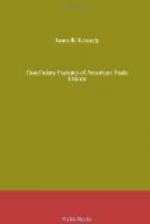* * * * *
The systems of so-called out-of-work benefits maintained by the Iron Molders, Pattern Makers, Tobacco Workers, Granite Cutters, Leather Workers on Horse Goods, and Locomotive Firemen, as has already been noted, merely exempt the unemployed member from payment of national dues. This is a device to retain members in “good standing” during unemployment.
The system maintained by the Iron Molders is the most important of those in operation. The history of the introduction of this benefit by the Iron Molders’ Union illustrates the conditions many unions face in building up a system of relief. As a union develops benefits the dues required of members are larger. The unemployed member thus finds himself heavily burdened by the dues he must pay his union at the very time he needs most the protection afforded by the benefit. The establishment of the out-of-work benefit in the Iron Molders’ Union was the direct result of the inauguration of a system of sick benefits in 1896. Members in arrears for dues for a period longer than thirteen weeks were excluded from sick relief. The limitation aroused serious dissatisfaction. It was felt that if an unemployed member could not be aided, at least he should be protected against the loss of his right to benefits. Some local unions paid the dues of their unemployed members, but in a period of depression the burden became too great. In October, 1897, two years after the inauguration of the sick benefit, the national union of the Iron Molders assumed the responsibility of paying the dues of unemployed members. All members of six months’ standing, who were not in arrears for more than four weeks’ dues, became entitled to relief from the payment of dues for thirteen weeks during any fiscal year. The out-of-work benefit does not begin, however, until two weeks after the member has become idle.[176] The national union issues through the local unions out-of-work stamps which are received in payment of dues.
[Footnote 176: Constitution, 1902 (Cincinnati, 1902), Art. 19. Until 1899 the unemployed member must not have been in arrears for more than four weeks’ dues, and the benefit did not begin until he had been idle four weeks. (Constitution, 1898.)]




